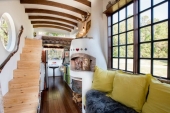posted 2 years ago
You've already got some good ideas here. The big issue seems to be the mass-iveness of the mass it self. Some ideas for that:
* Just do a rocket heater. Do everything you can to reflect that heat into the space to warm up the objects in the space.
* Of course, pennies of insulation is worth a pounds of mass... But you're in a buss... I don't know, is it possible to blow in insulation between panels of vehicles to up the R factor? Do people do that? It would making chasing wires a painus in the future, but it would make it warmer... Also, if my science is right (and I haven't checked with Fauchi, so I don't know for sure) radiant heat is just light... IR I believe... I think that reflects off glass and stays in the rig... the idea here is to think about what wavelengths are leaving the bus (is it buss or bus... my grammar may be wrong but I think my science is right). So consider your three types of heat transfer - Conduction, Convection, Radiation, figure out which is most important, then optimize trade-offs. Maybe simply having roll-down window shades would dramatically retain more radiant heat and help to reduce convection over the windows... Maybe you're willing to do flip down insulated flaps... maybe a blanket over windows...
* If the mass has gotta be inside the buss... Maybe you make the mass a large amount of water. OBVIOUSLY, you will do your due diligence and put in check valves... let's assume you're not an idiot and the system is safe... (and as soon as i post this, people who know nothing about steam will assume that any amount of warm water will explode... brace for comments...) Hear me out. Water would have lots of advantages. It means the mass can be anywhere, and any shape if you can safely move the water around. So that could be an insulated hot pipe that goes under the seats to reservoir(s)... You can drain it and drive away, there goes the mass part. Would be pretty cool to hook up a solar hot water heater to the same volume of water... could warm you a little for free in the sunny hours, taking in more heat when the RMH is on... maybe even use the hot water for practical things, like warm showers or washing dishes... Maybe you don't design the water part yourself... there's plenty of information out there, even finished boilers that can be obtained, with all the expertise and safeties that go with them. If you go with water, make sure you know how full it is before every use: you don't want super-heated steam finding holes into your small living space... Everyone's going to freak out at this suggestion to use water, but we've been using steam power for centuries. Even nuclear is a fancy way to make water hot. You're not even after steam you just want warm... So oversize...
* If you're not moving around a lot, modular mass might be enough. Consider bricks, pavers... any mass you can easily handle. The less expensive the better, maybe even expendable if you move on. Gravel may work, but it's less dense and has a lottttt of air pockets.... Also very hard to move around, makes a mess... not ideal. Consider staggering flat pavers to reduce the airflow between the pavers. The flatter the faces the better: less air = less air movement. Maybe you have some pieces that fit snugly over the pipe, to translate pipe shape into the standard paver size you have. Cob seems ideal... other stuff may work. Consult the oracle RMH builder's guide on permies... Yeah, so cobb (whatever) around your pipeing zones that you want to pull off heat, that should fill whatever awkward space allows you to then stack close bricks/pavers... (That would reduce the permanent mass, and make most of it modular.)
Whatever you do, be sure you're maintaining clean air in the small space. Manage fire exhaust AND make sure the fire isn't depleting all your O2. Redundant audible alarms should do the trick, if placed at the right locations/elevations. A heat exchanger wouldn't be a bad idea, little counter productive, but a good stupid-simple safeguard to make sure you'll always have another lung-full of O2. In a small space with a fire, I'd give my left lung to KNOW that my right lung would always have O2... of course, you could always draw outside air for the combustion, and that would help with the O2, but you'd have to trust your exhaust is sealed to protect from gas buildup. So outside air and sensors for carbon monoxide etc.










